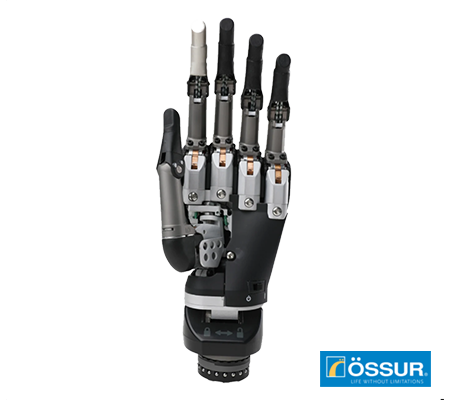The BIONIC* Hand
A replacement hand which resembles and acts like a real human hand, representing a generational advance in bionics and patient care.
The BIONIC Hand is a state-of-the-art prosthetic device that closely mimics the form and function of a human hand, marking a groundbreaking advancement in bionics and patient care. With five independently motorized fingers and powered thumb rotation, this next-generation device offers unparalleled dexterity and functionality.
Designed with Precision and Durability
Developed using advanced mechanical engineering techniques, the BIONIC Hand is constructed with premium materials such as titanium and high-strength plastics. The result? A lightweight, robust prosthetic that is as durable as it is functional. Its sleek and modern design appeals to both patients and healthcare professionals, setting a new standard in prosthetic innovation.
Intuitive Myoelectric Control System
At the core of the BIONIC Hand is a highly intuitive control system that uses traditional two-input myoelectric technology. By detecting electrical signals generated by the patient’s muscles, electrodes placed on the skin enable precise control of the prosthetic fingers. Users of basic myoelectric prosthetics will find the system easy to adapt to, mastering its enhanced functionalities in just minutes.
Gesture Control and Advanced Functionality
The BIONIC Hand incorporates gesture control, a revolutionary feature that allows automated grip functionality to be activated by moving the prosthetic in one of four directions. This modular design provides new levels of convenience and capability, offering a prosthetic solution unlike anything available before.
A Leap Forward in Patient Care
The BIONIC Hand not only restores physical function but also empowers users with confidence and independence. Its innovative features and user-friendly design make it a transformative tool for both new and experienced prosthetic users.


Artificial Limbs
Prosthetic Legs or Arms; Prostheses can help people with leg and/or arm amputations get around more easily. Prosthetic Devices mimic the function and, sometimes, even the appearance of a real body parts. Some people may require a cane, walker, or crutches to increase stability while walking, while others can walk, and even run without encumbrance.
Prosthetic Technology Is Evolving
There are constant developments in prosthetic limb technology, such as microprocessor-driven and activity-specific components.
- Microprocessor joints feature computer chips and sensors to provide a more natural gait. They may even have different modes for walking on flat surfaces or up and down the stairs.
- There are also specialized prosthetic legs for different activities, such as running, showering or swimming, which you can switch to as needed. In some cases, your everyday prosthetic leg can be modified by your prosthetist to serve different purposes.
- Osseointegration surgery is another option. This procedure involves the insertion of a metal implant directly into the bone, so there is no need for a socket. The prosthetic leg then attaches directly to that implant. While this procedure is not right for everyone and is still under study, it can provide improved range of motion and sensory perception.
It’s important to remember that you’re not alone in navigating the many different prosthetic leg options. Your care team will help you weigh the pros and cons of each and decide on the ideal prosthetic leg that matches your lifestyle.
Design, structure, and fitting an orthosis can be a complex process.
3 Steps to Create an Orthosis
-
1
Assessment
Medical, physical, bio-mechanical, muscle strength, proprioception, and sensation
-
2
Design & Manufacturing
materials, construction, suspension, and cosmesis
-
3
Fitting and Evaluation
anatomical fit, function, easy to don/doff, comfortable to wear